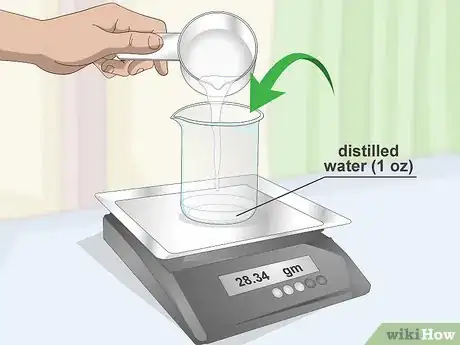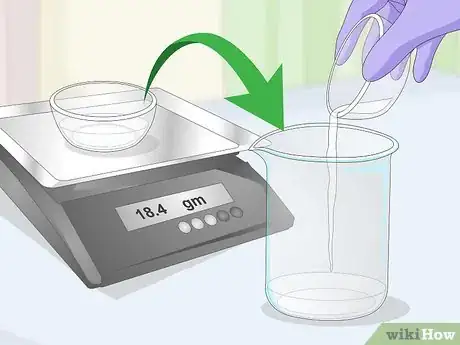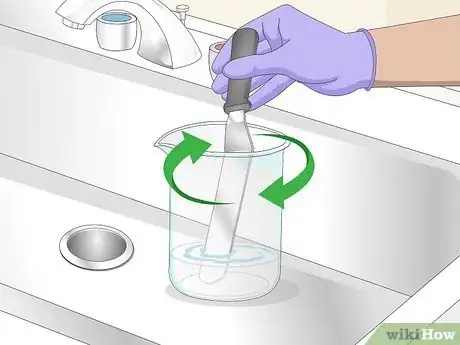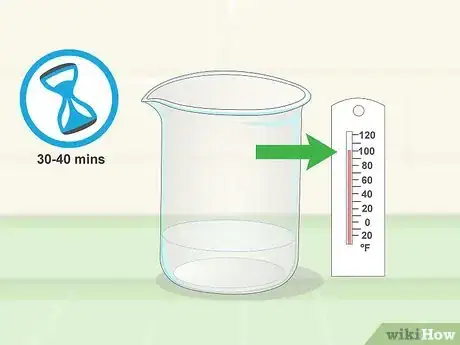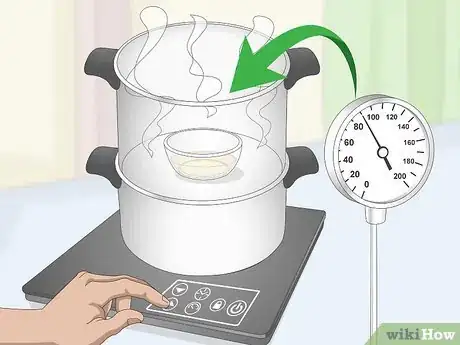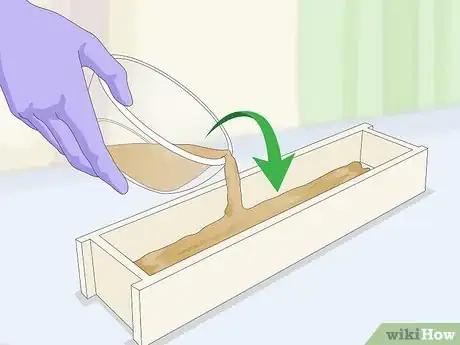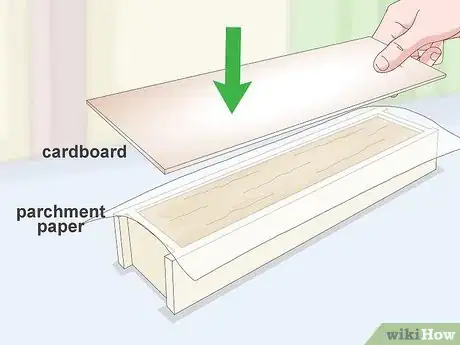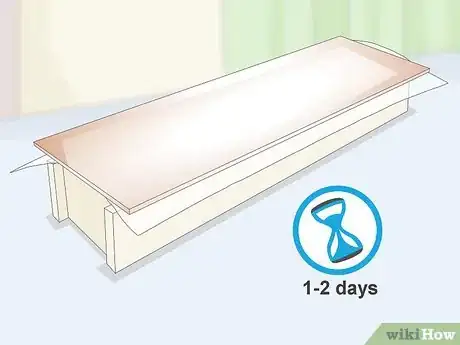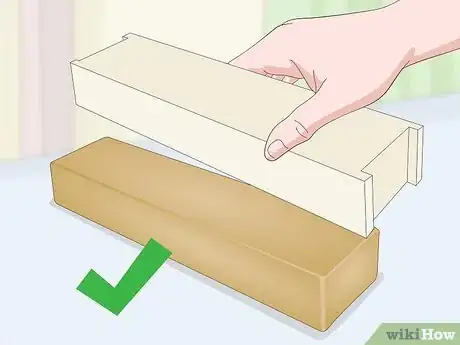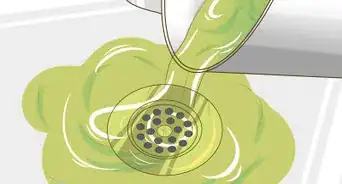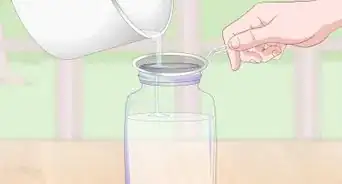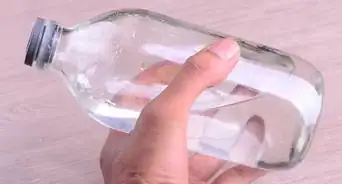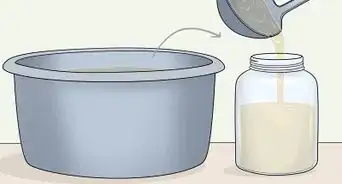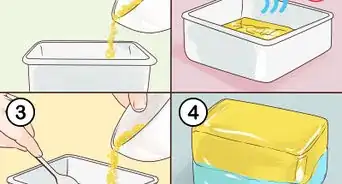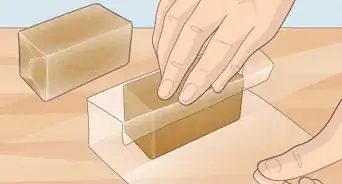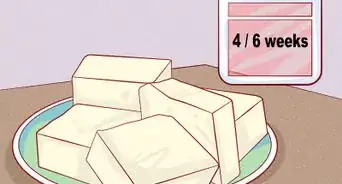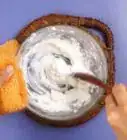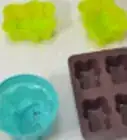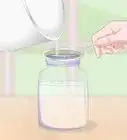This article was co-authored by wikiHow Staff. Our trained team of editors and researchers validate articles for accuracy and comprehensiveness. wikiHow's Content Management Team carefully monitors the work from our editorial staff to ensure that each article is backed by trusted research and meets our high quality standards.
This article has been viewed 18,837 times.
Learn more...
Aleppo soap is a traditional Syrian soap made with olive oil and laurel berry fruit oil. It is made with all natural ingredients, and works well to soothe sensitive skin. While you can often find Aleppo soap in stores, it's also possible to make it at home. You only have to mix the oils with a lye solution at the right temperature, pour the liquid soap into molds, and allow it to cure for several week before using. The process isn't difficult, but working with lye can be dangerous, so be sure to follow proper safety precautions.
Ingredients
- 4 Ounces extra virgin olive oil (113.40 Grams)
- 1 Ounce laurel berry fruit oil (28.35 Grams)
- 0.65 Ounces lye - sodium hydroxide (18.43 Grams)
- 1 Ounce Distilled water (28.35 Grams)
Steps
Preparing the Lye Solution
-
1Put on your safety gear. Making the soap requires working with lye, which is highly corrosive and can burn the skin on contact. Before you begin mixing up the soap, put on a pair of protective gloves and safety goggles just in case of splashing. It’s also a good idea to wear a long-sleeved shirt to protect your arms as well.[1]
- For safety reasons, you shouldn’t allow children to help you make the soap.
-
2Measure out the water in a heatproof container. It’s important to have precise measurements when you’re making soap, so it’s best to weigh the ingredients. Pour 1 oz (28 g) of distilled water into a heatproof container, and check that it weighs 28.34 grams on a digital kitchen scale.[2]Advertisement
-
3Weigh the lye and add it to the water. Pour 0.65 oz (0 g) ounces of lye (sodium hydroxide) into a separate container, and place it on the kitchen scale to ensure that it weighs 18.4 g (0.65 oz). Next, carefully, pour the lye into the distilled water.[3]
- Make sure that the lye you’re using is labeled as 100% sodium hydroxide.
- You can find lye at some hardware stores in the drain cleaning section, but it’s widely available at online retailers that sell soap making supplies.
-
4Stir the water and lye together well. As soon as you’ve added the lye to the distilled water, use a spatula to mix the two together. Continue stirring until the lye is completely dissolved. The mixture will get very warm and give off fumes quickly, so it’s best to work beside an open window.[4]
- If possible, you may want to mix the water and lye together in your kitchen sink. That way, if there are any splashes or spills, they’ll be easier to clean up.
-
5Allow the mixture to cool in a safe place. After the lye has dissolved and the solution has warmed up, set it in a safe, secure location. Let the mixture cool down for 30 to 40 minutes, so it reaches a temperature between 100 to 110 °F (38 to 43 °C).[5]
- Make sure that the lye mixture is out of reach of children and pets.
- It’s a good idea to label the container too, so no one accidentally touches or tries to drink it.
- You can use a digital kitchen thermometer to test the mixture’s temperature.
Warming the Oils
-
1Measure the oils and add them to the top of a double boiler. Pour 4 oz (110 g) extra virgin olive oil into a medium bowl, and make sure that it weighs 113.4 grams. Next, add 1 oz (28 g) of laurel berry fruit oil to the bowl, and check that it adds an extra 28.4 g (1.00 oz) of weight on the scale. Place the bowl on top of a double boiler on the stove.[6]
- Be sure to use laurel berry fruit oil, not bay laurel or laurel leaf essential oil. Laurel berry fruit oil can be difficult to find, but many online retailers sell it.
-
2Heat the oils gently until they reach 90 to 100 °F (32 to 38 °C). Turn the burner on to low heat, so the oils begin to warm up. It should take about 5 to 7 minutes for the oils to reach the right temperature.[7]
-
3Remove the oils from the double boiler. Once the oils have reached the proper temperature, carefully lift the bowl out of the double boiler. Place it down on a heatproof surface, such as a trivet.[8]
- It’s a good idea to place the trivet that you set the bowl on in your sink to catch any possible spills or splashes.
Molding the Soap
-
1Pour the lye solution into the oils and blend until trace is reached. When the lye solution has reached the right temperature, carefully add it to the oils. Mix the solution until it becomes thick enough that when you lift the spoon out of the mixture, the drizzle leaves an imprint on the surface before sinking in, which is known as trace.[9]
- You may find it easier to use an immersion blender to mix the soap until it reaches traces.
-
2Add the soap mixture to the mold(s). The recipe makes about 10 ounces (283 grams) of soap. The number of molds that you’ll need will depend on how large they are. Smooth the soap in place with a spatula for an even surface.[10]
- You can purchase soap molds at craft stores and online retailers that sell soapmaking supplies.
- Depending on your preference, you can choose smaller molds that form individual soap bars or a single large mold that makes a long bar that you can then slice into individual bars after it’s set.
- If you don’t have soap molds, you can use silicone baking molds.
-
3Cover the molds with parchment paper and cardboard. To help insulate the soap as it dries, set a piece of parchment paper over each mold. Next, lay a sheet of cardboard over the paper to trap the heat further.[11]
- Some molds come with lids, so you can just use them instead of the parchment paper and cardboard.
- If the area that you’re working in is cold, you may want to further insulate the molds with a blanket or towel.
-
4Let the soap sit in the mods for 1 to 2 days. For the soap to set properly, they should sit in the mold for at least 24 hours. If you’re in a very humid location, though, it may take up to 48 for the soap to set.[12]
-
5Remove the soap from the molds and cure for several weeks. When the soap is fully set, carefully unmold it. If you’ve used a larger mold, you can cut the soap into bars. Because of the high amount of olive oil in the soap, it needs to cure for a fairly long time before you use it so let it sit out exposed to the air for at least 6 to 8 weeks.[13]
- Curing the soap allows the water in it to evaporate so it becomes harder, which helps it last longer. It also helps the soap become gentler, so it doesn’t irritate the skin when you use it.
- Allowing the soap to cure for 6 months to a year can make it even better.
Community Q&A
-
QuestionI made Aleppo soap for the first time yesterday, and noticed that there are crystals on the surface. Is this normal? It also went really fast to trace.
 KathyCommunity AnswerThat's normal if it went fast to trace. Crystals are usually okay too. However, if they are inconvenient, scrape them off. You could even make them into crystals and decorate with them!
KathyCommunity AnswerThat's normal if it went fast to trace. Crystals are usually okay too. However, if they are inconvenient, scrape them off. You could even make them into crystals and decorate with them! -
QuestionI made Aleppo soap but it did not dry and is looking clumpy. It has been 3 days now. Is there any way I can salvage it?
 Mzm555Top AnswererProbably not - it would probably be much more trouble than it's worth trying to re-batch it or work it into another batch, possibly ruining that one as well. Possibly try a different recipe and double check all ingredient amounts putting them through a soap calculator such as "soap calc" or "mms". Also ensure you are doing all soap making steps correctly, such as stirring the lye water solution until clear, using enough water, using de-mineralized/distilled/r.o. or purified water and using a stick blender to reach trace. If you are still not having any luck consider attending a small course/workshop for some assistance - most local soapmakers run them and they are an excellent resource!
Mzm555Top AnswererProbably not - it would probably be much more trouble than it's worth trying to re-batch it or work it into another batch, possibly ruining that one as well. Possibly try a different recipe and double check all ingredient amounts putting them through a soap calculator such as "soap calc" or "mms". Also ensure you are doing all soap making steps correctly, such as stirring the lye water solution until clear, using enough water, using de-mineralized/distilled/r.o. or purified water and using a stick blender to reach trace. If you are still not having any luck consider attending a small course/workshop for some assistance - most local soapmakers run them and they are an excellent resource! -
QuestionWhere can I buy laurel berry oil?
 Mzm555Top AnswererProbably only online - make sure you buy from soap-making or cosmetic websites as they will often be able to sell you the oil much cheaper in bulk quantities (around 20-40 fl oz- or 500ml to 1L). Most retail and boutique online sellers often sell oils at much higher prices - especially essential oils.
Mzm555Top AnswererProbably only online - make sure you buy from soap-making or cosmetic websites as they will often be able to sell you the oil much cheaper in bulk quantities (around 20-40 fl oz- or 500ml to 1L). Most retail and boutique online sellers often sell oils at much higher prices - especially essential oils.
Things You’ll Need
- Digital kitchen scale
- Two heatproof containers
- Rubber spatula
- Digital kitchen thermometer
- Medium bowl
- Sauce pan that the bowl fits in (for double boiler)
- Soap mold(s)
- Parchment paper
- Cardboard
References
- ↑ https://thenerdyfarmwife.com/soap-making-101-making-cold-process-soap/
- ↑ https://thenerdyfarmwife.com/aleppo-soap-recipe/
- ↑ https://thenerdyfarmwife.com/aleppo-soap-recipe/
- ↑ https://thenerdyfarmwife.com/aleppo-soap-recipe/
- ↑ https://thenerdyfarmwife.com/aleppo-soap-recipe/
- ↑ https://thenerdyfarmwife.com/aleppo-soap-recipe/
- ↑ https://thenerdyfarmwife.com/aleppo-soap-recipe/
- ↑ https://thenerdyfarmwife.com/aleppo-soap-recipe/
- ↑ http://www.lovinsoap.com/2017/03/aleppo-soap-recipe-soap-inspired-aleppo-laurel-soap-recipe/
- ↑ http://www.lovinsoap.com/2017/03/aleppo-soap-recipe-soap-inspired-aleppo-laurel-soap-recipe/
- ↑ https://thenerdyfarmwife.com/aleppo-soap-recipe/
- ↑ http://www.lovinsoap.com/2017/03/aleppo-soap-recipe-soap-inspired-aleppo-laurel-soap-recipe/
- ↑ http://www.lovinsoap.com/2017/03/aleppo-soap-recipe-soap-inspired-aleppo-laurel-soap-recipe/

